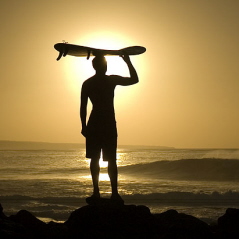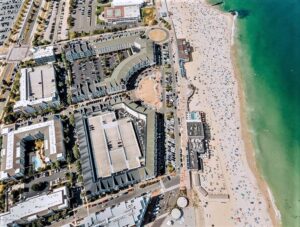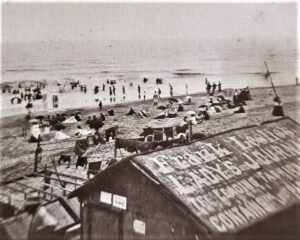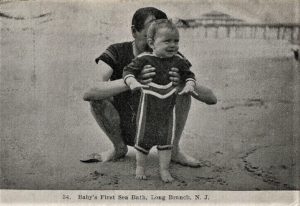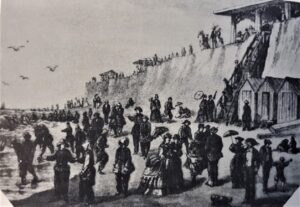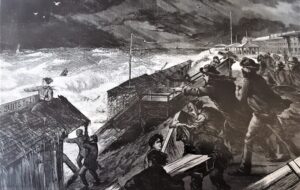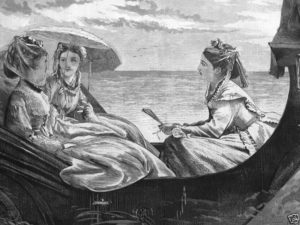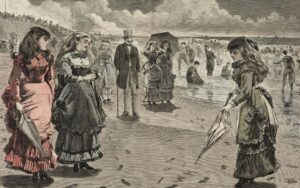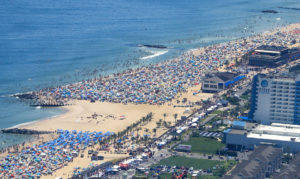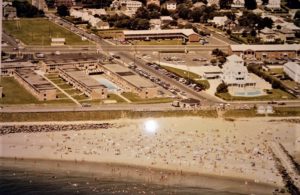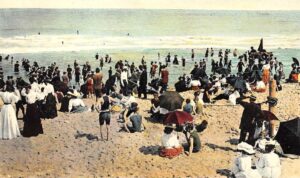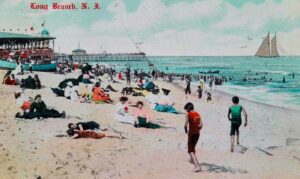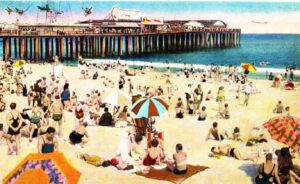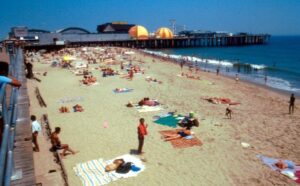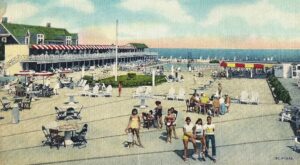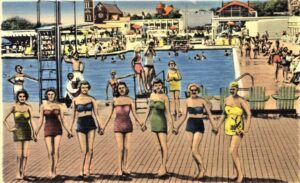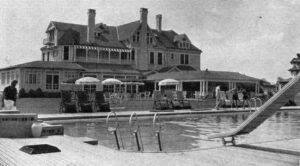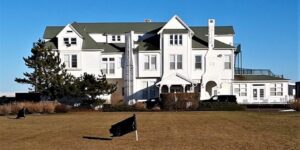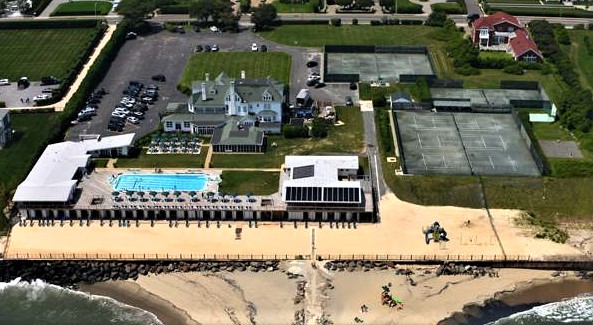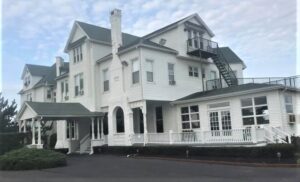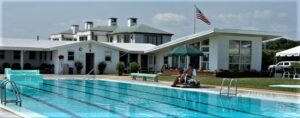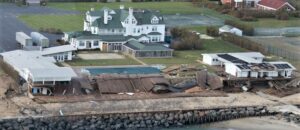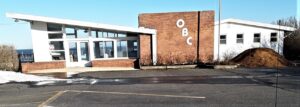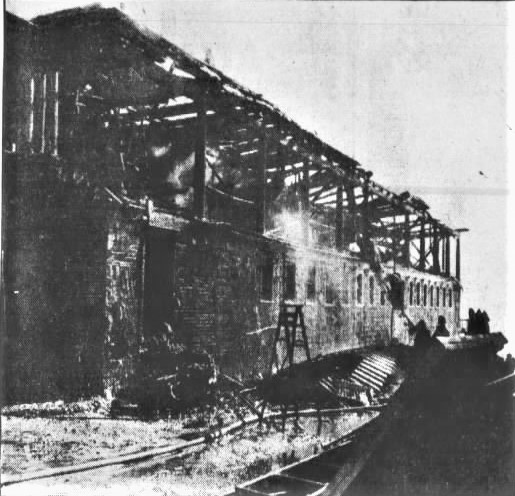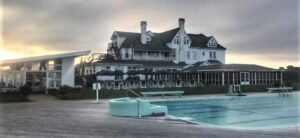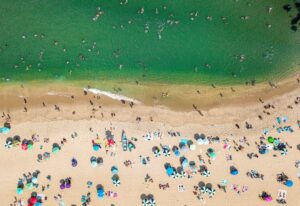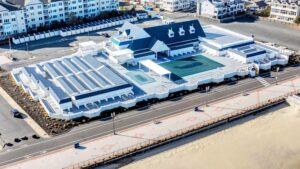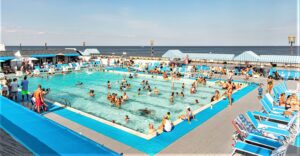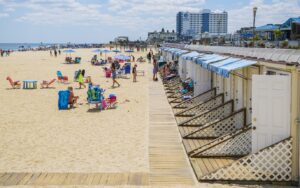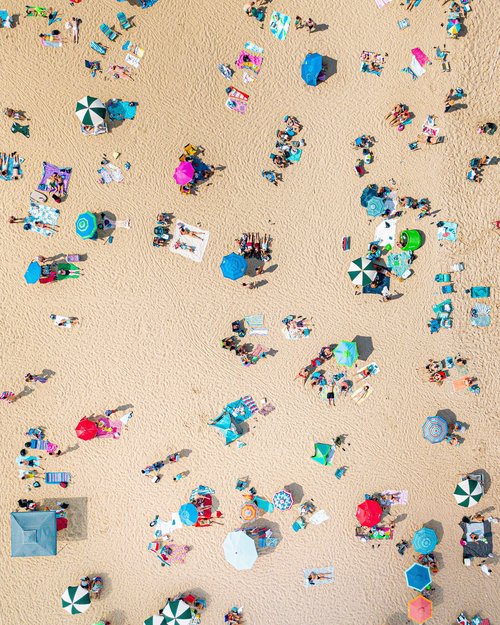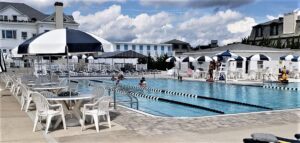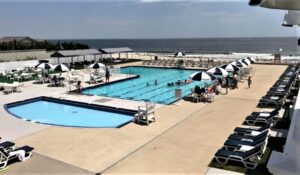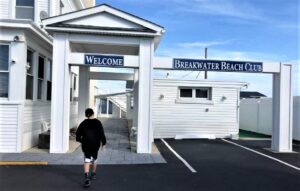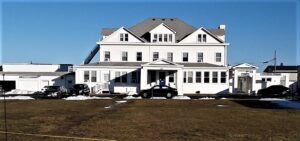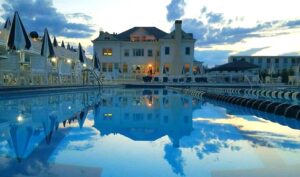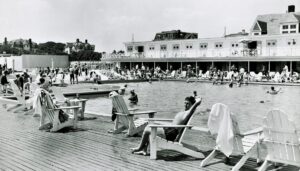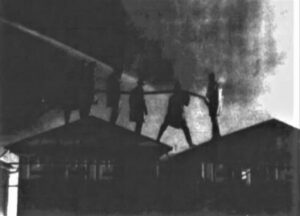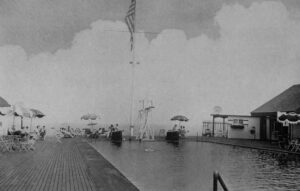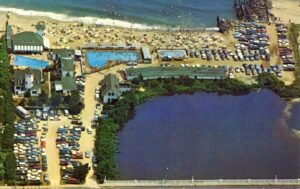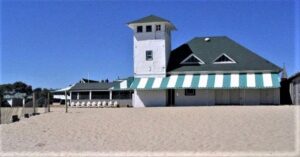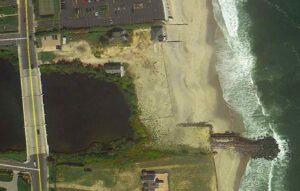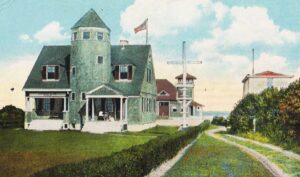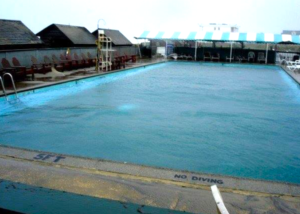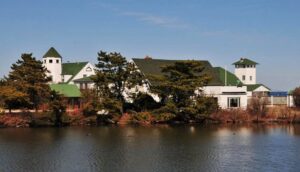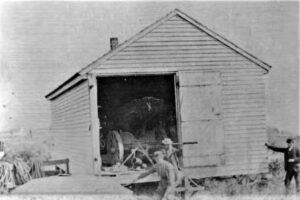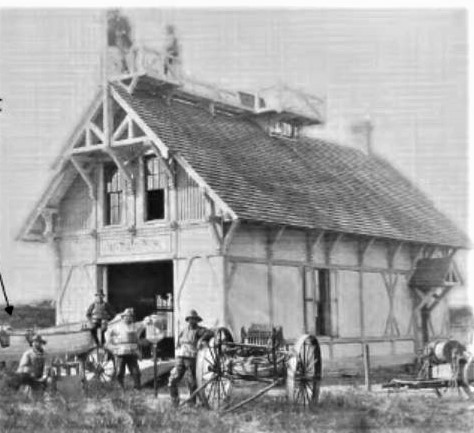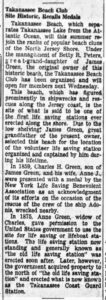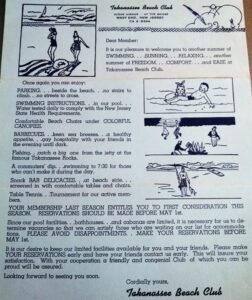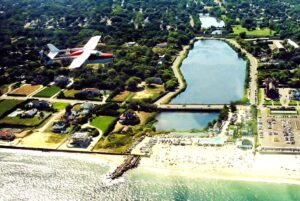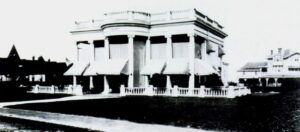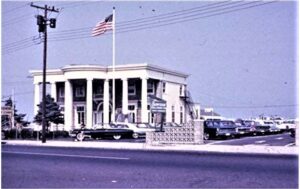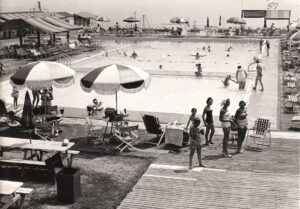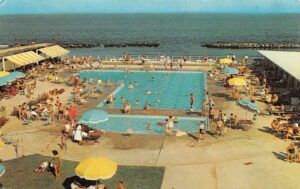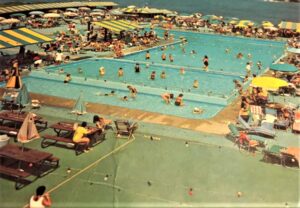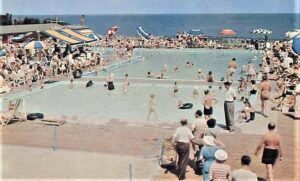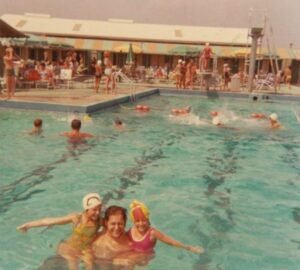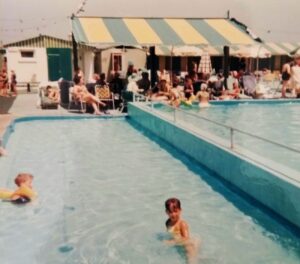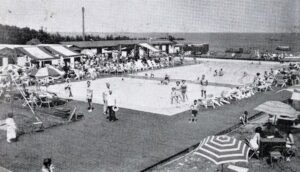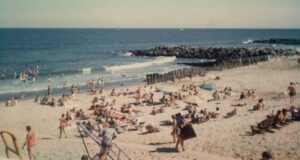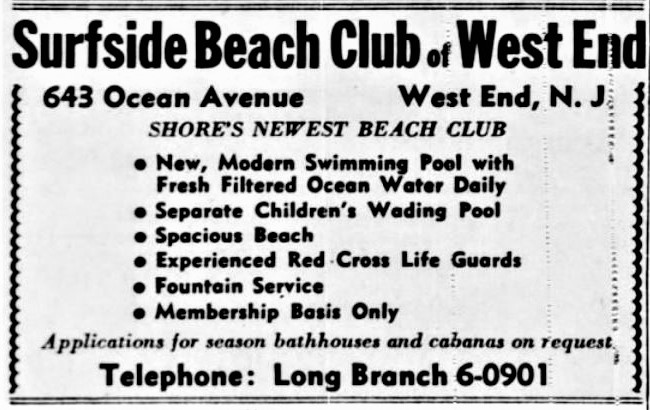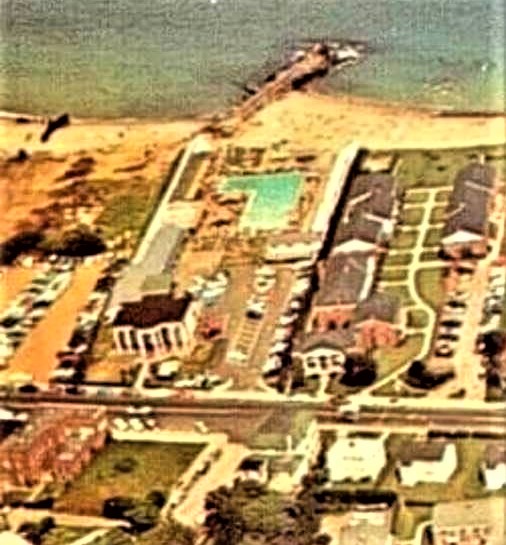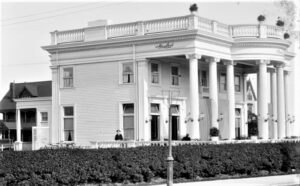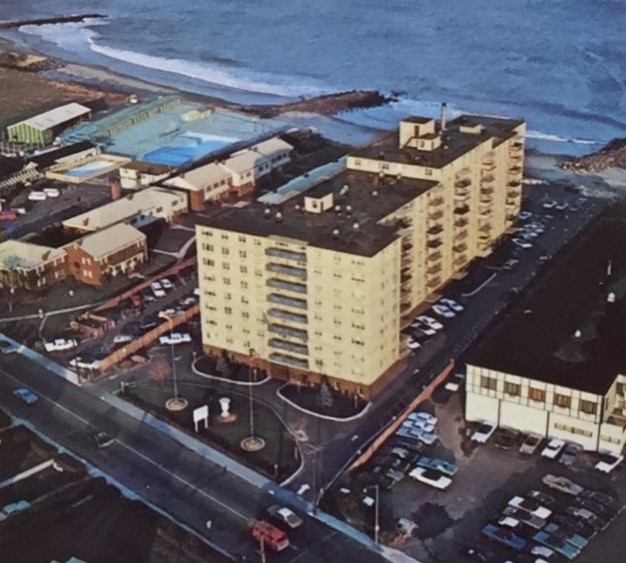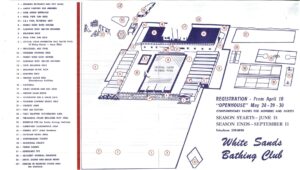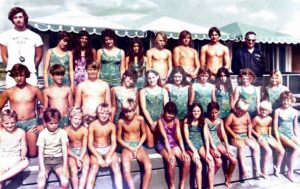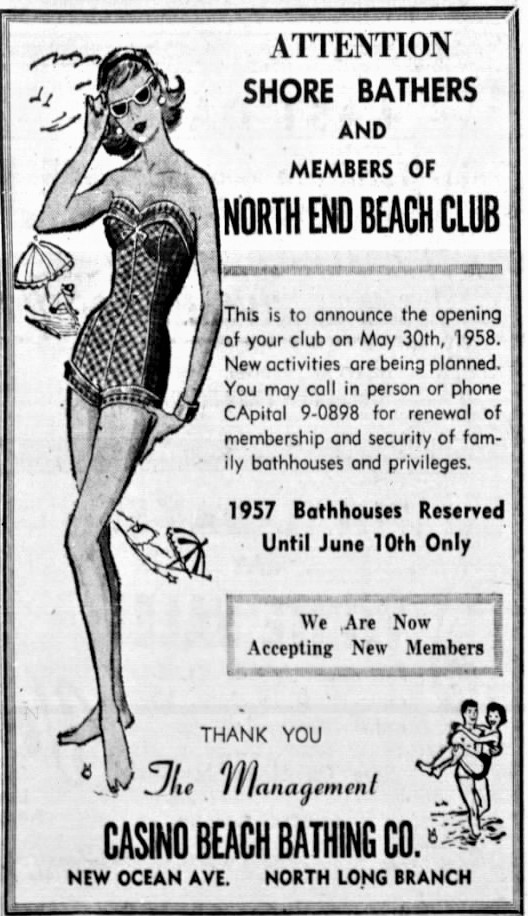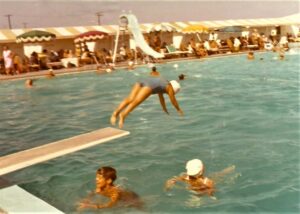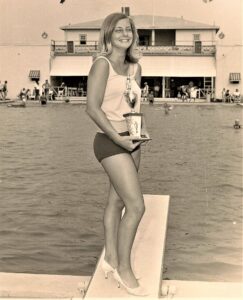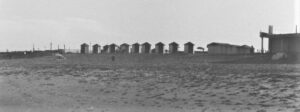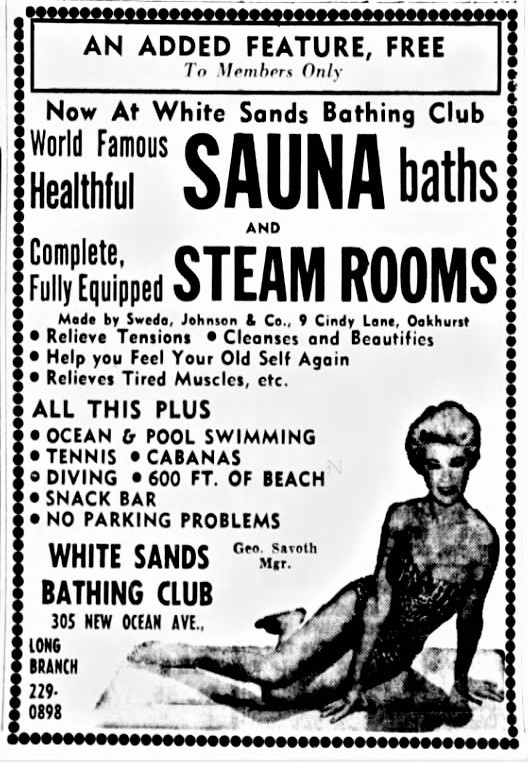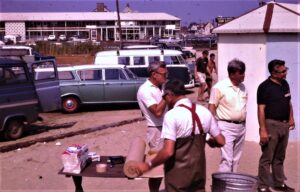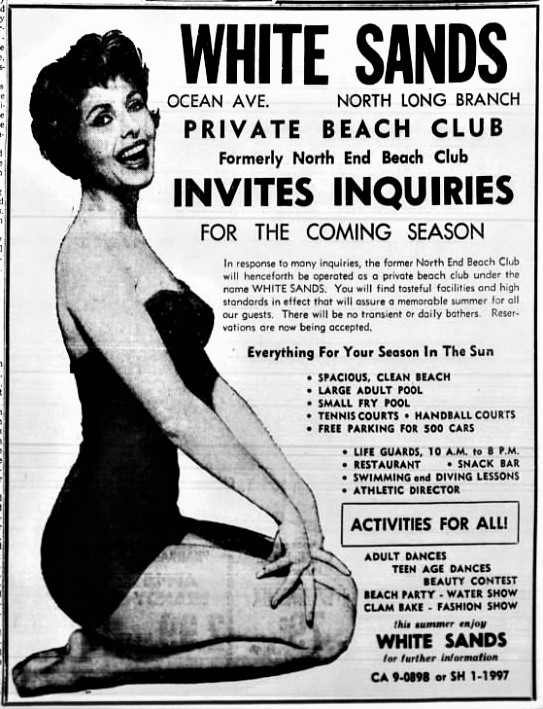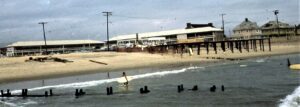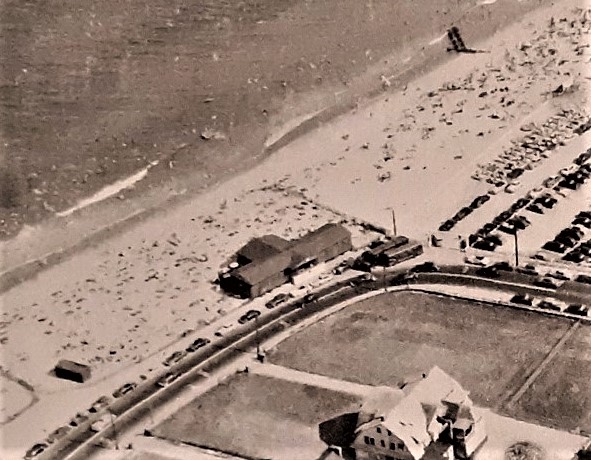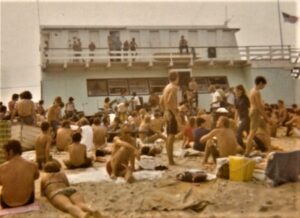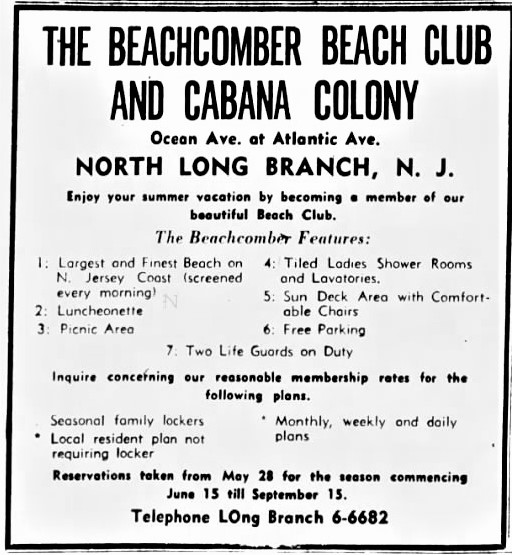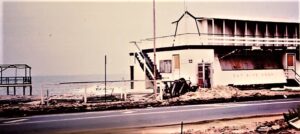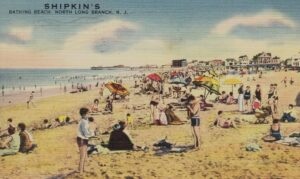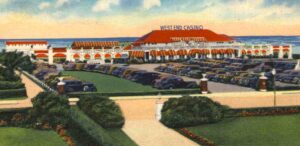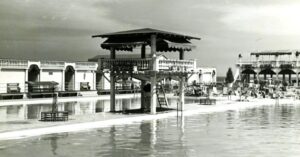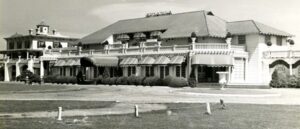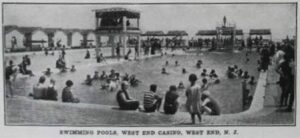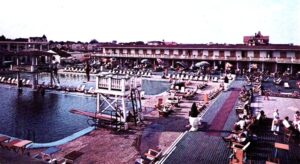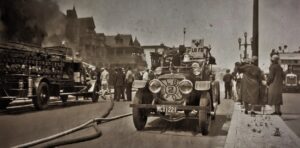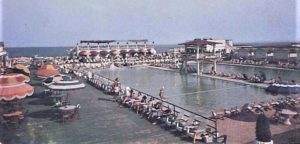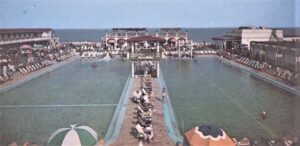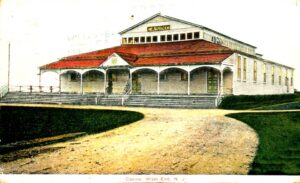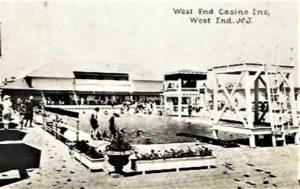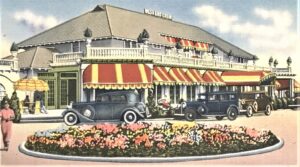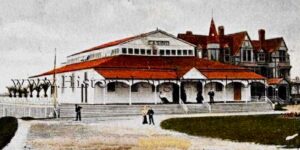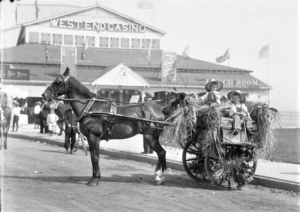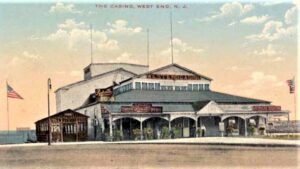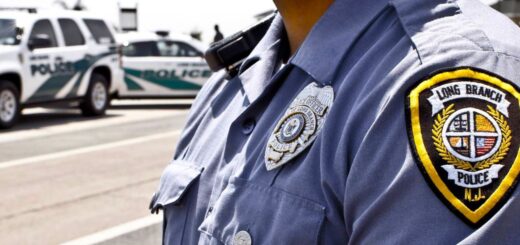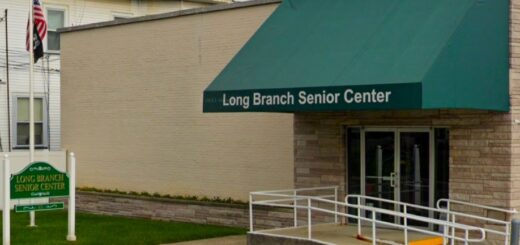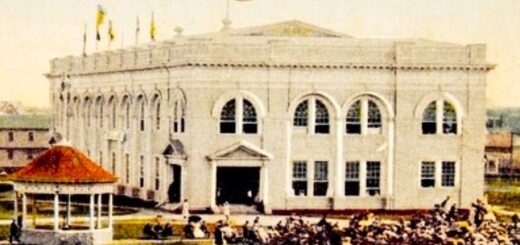Long Branch: City of Beach Clubs
Photo-essay on city sand, sea and sun …
Long Branch is a beach town — one of the best ever. Shore lovers have known it for 150 years now. During my Long Branch history research I’ve found few things to elicit more nostalgia than when folks talk about their favorite local beach clubs. They are central to the city’s identity and appeal.
Long Branch has much to offer here. The following information and imagery represents many glorious summers at city beaches. I’ve sought to identify all the clubs and offer a brief background on each. Some fact, some fiction. Being a shore person myself, I already know that we all treasure our beach clubs — past and present.
Today, most of the Long Branch coastline is open to the public. The city operates a series of public beaches along its 5-mile coastline — with double-digit access locations provided. And a weekend day at a city beach is still under $10. Long Branch officially entered the “beach club” business in 1931 when the city hired its first lifeguards.
Today, only four private beach clubs remain active in Long Branch. Ocean Beach Club — opened in 1906 and still operating in Elberon — is the city’s oldest. Promenade Beach Club, opened in 2000 in Beachfront North, is the newest:
• Ocean Beach Club
• Breakwater Beach Club
• Elberon Bathing Club
• Promenade Beach Club
• Long Branch City Beach Department
There were many other Long Branch beach clubs, of course, now gone and forgotten. Here’s a look at the city’s shore life and its beach clubs over the years. Those with more info or photos please share — HERE. Enjoy:
Long Branch beach scenes …
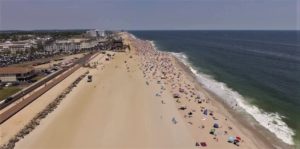
’24 City Beach Fees — Long Branch coast looking north, 2016. City public beach fees for Summer 2024 are set — an adult (18-61) beach pass is $70; students pay $30. For seniors, children, vets, and the disabled city beaches are free. The daily weekend rate is $9 — MORE INFO.
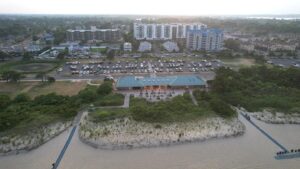
’24 County Beach Fees — Seven Presidents Oceanfront Park aerial image, Summer 2022 (David Booth Photo) — For Summer ’24, the county park charges $75 for an adult (18-64) season pass; it’s $30 for seniors (vets and kids are free). Here a day of parking and the beach remains $20 — MORE INFO.
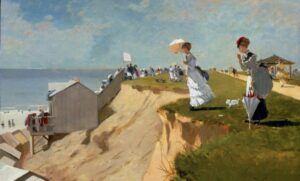
Unmatched Location — ‘Long Branch, New Jersey” by Winslow Homer, 1869. Known popularly as “The Bluffs” — it’s the ultimate Long Branch “beach” image and yet city historians are uncertain of the exact location of this iconic Gilded Age oil painting. The best estimate is along Ocean Avenue between Morris and Pavilion Avenues. The Museum of Fine Arts in Boston acquired the artwork in 1941 paying $2,800. Many regard Homer “as the greatest American painter of the 19th century,” according to the Metropolitan Museum of Art in NYC.
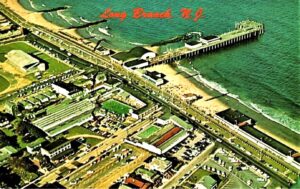
Super Summers — “Pool Club Row,” 1950s. Located on the west side of Ocean Avenue were three public bathing facilities — Cranmer’s Baths, Chelsea Baths and Columbia Baths — MORE INFO.
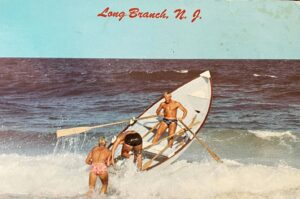
To the Rescue — Long Branch lifeguards in action, 1960s. During the 1960s city public beaches were considered “the safest in New Jersey,” according to the Long Branch Daily Record. The city had started the first lifeguard training school in June 1962. That summer most lifeguards were paid 75 cents per hour.
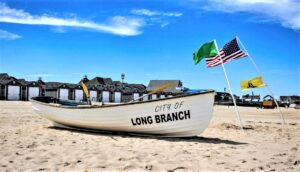
50 Summers Ago — City of Long Branch lifeguard boat, 2021. Half a century ago, Summer 1974, the starting salary for city lifeguard was $85 per week (for 6 work days). Jim Simonelli led the 27-lifeguard contingent that seasaon. The total city beach budget was under $150,000 that year. For summer ’24, the city will appropriate 10 times that amount to run Long Branch public beaches.
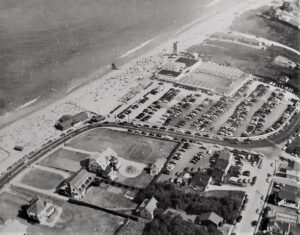
Beach Days — Old Ocean Avenue winds though coastal North Long Branch in this aerial image, 1952. On top is the North End Beach Club; it became White Sands Beach Club in Summer 1961. The USO Beach Club is the beach building at left center.
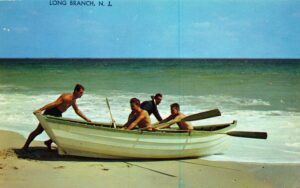
All in a Row — Long Branch city lifeguards, 1957. “Watchers of the lives of people; guardians of pleasurable weekends and vacations.” —Long Branch Daily Record, August 1941.
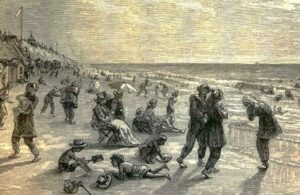
“Bathing Hour at Long Branch,” Harper’s New Monthly Magazine, September 1876. “Regard the bathing-master — he is thoroughly familiar with the tides, temperature and formation of bars, manner and effects of bathing and all that relates to it. You will be safe if you regard his directions.”—A Complete Descriptive Guide of Long Branch, NJ by J.H. Schenck, 1868. The “bathing-masters” were employed by the large oceanfront hotels that ruled Long Branch summers at the time.
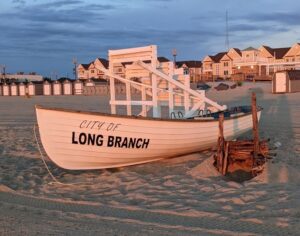
#1 — Another day dawns on city beaches, August 2023 (Robert Goodman Photo). The city’s first paid lifeguards were in Summer 1931.

#2 — Another day dawns on city beaches, 2019. For Sumner 1980, a Long Branch season beach pass was $10; the daily weekend rate was $1.50. In Monmouth Beach it was $20 for the season. In Sea Bright it was $12.50 for the season; $1 on weekends.
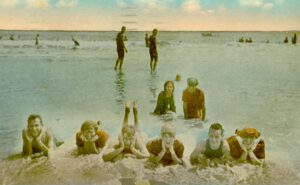
“Beach at Long Branch, NJ,” 1915 postcard. “Safe Beach Day” at Long Branch, NJ — MORE INFO.
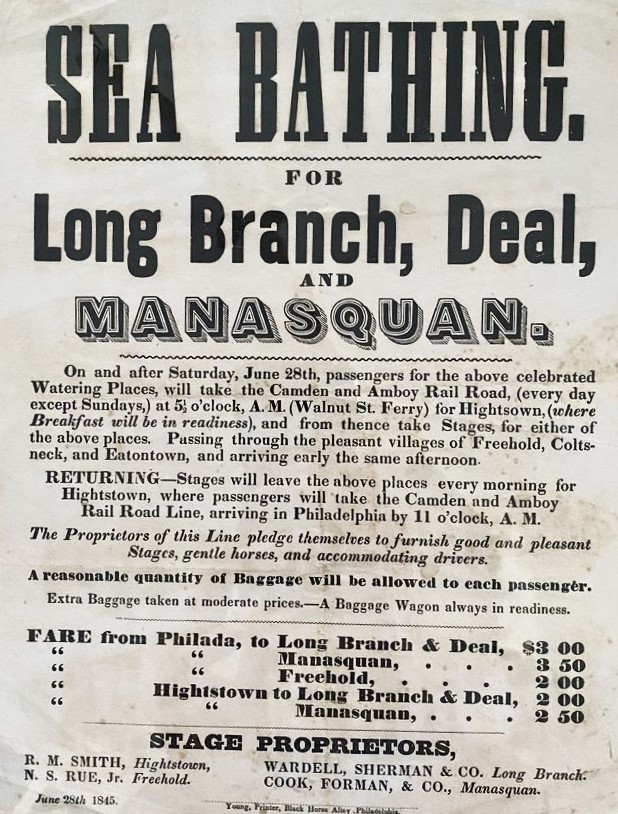
Drive to Dive — “Sea Bathing for Long Branch … ” From Philadelphia for just $3 a day for “celebrated Watering Places.” The first Long Branch beach lovers in June 1845 traveled 70+ miles to get there.

Long Branch’s Rembrandt — Winslow Homer, 1860s. Born in Boston in February 1836, he first came to paint in Long Branch in 1869 and naturally fell in love with the sea and a girl. While encouraged some by his mother, Homer was largely a self-taught artist. For all his prized work on Long Branch seascape tranquility and serenity, Homer also saw the Civil War from the front as artist-correspondent for Harper’s Magazine. He died in 1910. (NJ State Archives Photo).
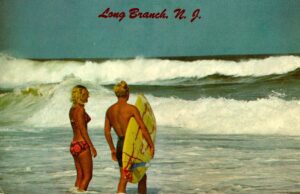
“Surf’s Up” — Long Branch oceanfront postcard, 1960s. City beaches helped popularize surfing at the Jersey Shore. According to a long-term Beach Erosion Board study on wave height at Long Branch beaches ending in 1949, it was determined that 98% of waves were 6 foot or lower (a height that begins to attract the better surfers).
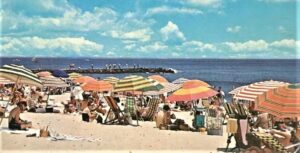
Beach day in Long Branch, 1960s. By Summer 1966, according to the Long Branch Daily Record, the city had 19 beach clubs along its 5-mile stretch of oceanfront — 9 public and 10 private.
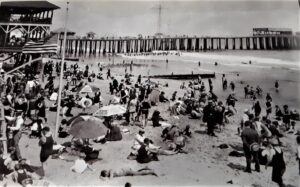
Busy summer day in Long Branch, 1923. FYI — Dixon’s Bathing Pavilion at the foot of Broadway opened in 1925; J.C. Dixon ran the 60-bathhouse operation.
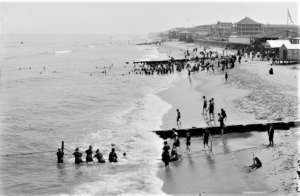
Long Branch swimmers test the waters, 1900. Even as late as Summer 2019, the city paid beginner lifeguards just $9.50/hour. Today a starter guard gets about $17/hour.
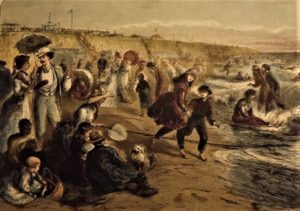
Bluffs, beach and bathers at Long Branch, 1875. “The sun shines brightest on the Long Branch shores.” —Ladies Home Journal, August 1947.
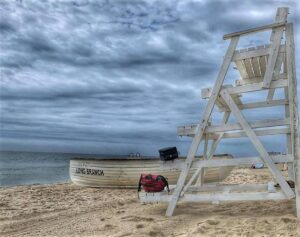
Shore Protection — City lifeguard stand on a cloudy summer day, 2020. By 1959, the average city lifeguard was earning $50 per week and $1,500 covered a whole summer of their salaries.
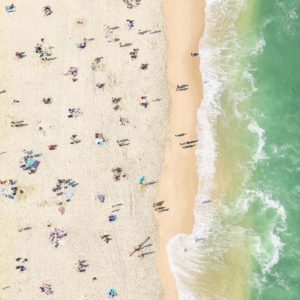
Good Guards — Summer of social distancing at a city beach, July 2020. It wasn’t until Summer 1963 when the city mandated certified training for all lifeguards. City beach supervisor “Army” Ippolito led the effort, according to Long Branch Daily Record. Ippolito, who coached LBHS to five state football championships and later served as a Long Branch city councilman, died in June 1980.
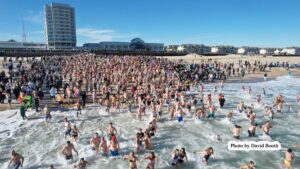
Off Season — More than 800 hearty souls participated in the annual Sons of Ireland Polar Plunge staged in Long Branch at the Ocean Place Resort, New Year’s Day 2023 (Dave Booth Photo).
Colony Surf Club
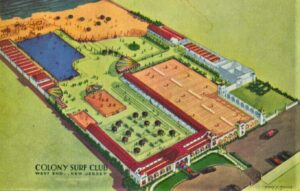
Colony Surf Club, 1938. Arguably the city’s most stylish and swanky beach club, the massive West End facility operated for parts of four decades (1933-1966).
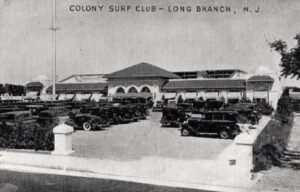
Colony Surf Club, 1930s. Built at the height of the Great Depression, the private beach club would become a summertime paradise for generations of city families.

Colony Surf Club, 1944. Owner Harry J. Reicher opened the doors in June 1933 and ran it for a decade of summers.
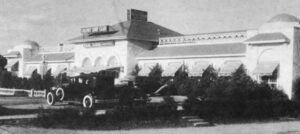
Colony Surf Club on Ocean Avenue, 1935. Reicher also owned the Hollywood Hotel (with Harry Freedman) acquired in a 1925 foreclosure and they held it for 25 years.
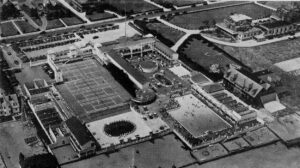
Colony Surf Club, 1936. Ocean Avenue at the top — crowns a breathtaking view of the massive beach club grounds.
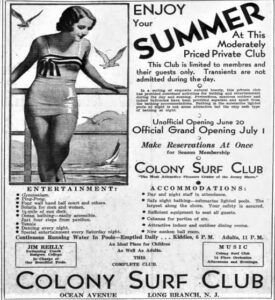
Colony Surf Club “Official Grand Opening.” Long Branch Daily Record, June 1933. Film star Robert Montgomery was on hand for the opening.
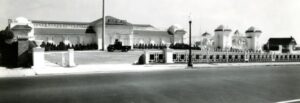
Colony Surf Club, 1940s. By Summer 1942 it claimed to have the Jersey Shore’s “largest and finest pool.”
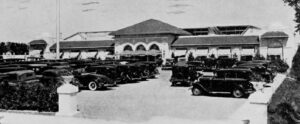
Colony Surf Club, 1930s. Jerry Pressman and Benjamin Zuckerman bought the club from Harry Reicher in 1944 and sold it (along with the nearby West End Casino beach club) in 1945 for $500,000.
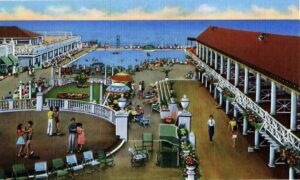
Colony Surf Club postcard, 1947. By the early-1950s, the club had 84 cabanas and 280 bathhouses and a season full of activities.

Colony Beach Club, 1930s. Membership declined in later years and the club was torn down in September 1967. The property was sold at sheriff’s auction in December 1968.
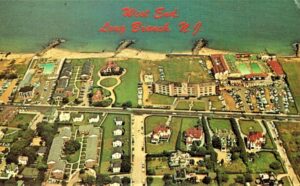
West End postcard, 1960s. The Colony club at upper right was acquired by Henry and Bernice Kempler in 1961.
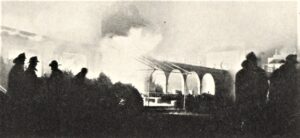
Colony Surf Club is ablaze, October 1948. All of the city’s fire companies, four from shore area towns and the US Coast Guard battled the “fiercely burning” fire. A new club was rebuilt for $221,000. Ross Enterprises, Inc. was the owner. After the fire, the Sand & Surf Hotel management took control of the property.
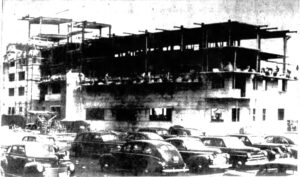
Sand & Surf Hotel undergoing construction on Ocean Avenue in West End, May 1950. It was the old Colony Surf Club grounds. It later become the Harbor Island Spa.
Ocean Beach Club
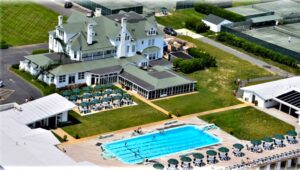
Ocean Beach Club, 2013. First organized in 1906 and still operating today — it’s the oldest beach club in Long Branch.
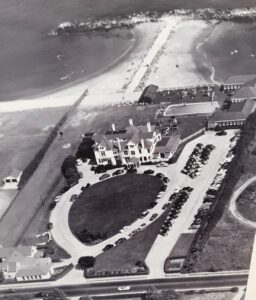
Ocean Beach Club on Ocean Avenue, 1940s. William Rosenfeld was an original founder and the first OBC president which included 25 charter members.
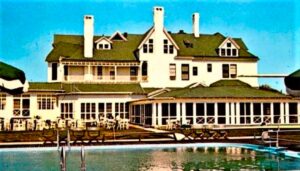
OBC, 1966. Rosenfeld — also a city commissioner and successful diamond merchant — was born in Oregon in 1868. He donated $100,000 to Monmouth Memorial Hospital when he died in 1957.
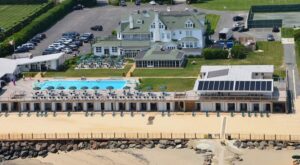
Ocean Beach Club, today. Samuel Sestito spent a half-century of summers at the OBC, beginning as its superintendent in 1920 until his death in 1970.
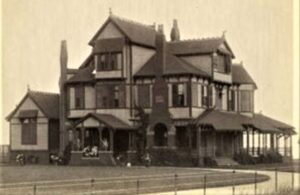
Ocean Beach Club in Elberon when it was a private home, 1880s. The house was owned by Temple Bowdoin and later Lewis Gawtry, who sold it to the club in 1921 for $31,500. The Gawtry family made a fortune in banking and natural gas.
Promenade Beach Club
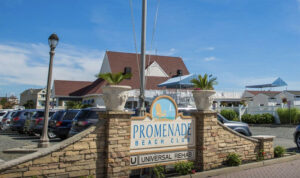
Promenade Beach Club on Cooper Avenue, 2019 — MORE INFO.
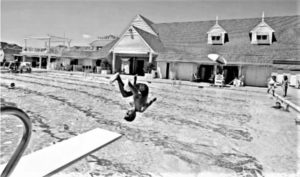
Promenade Beach Club pool area, 2019. Located in Beachfront North, it’s the city’s most modern beach club.
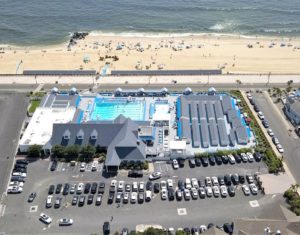
Promenade Beach Club aerial image, 2010s. Located on the old NJ National Guard armory property, the club opened in May 2000.
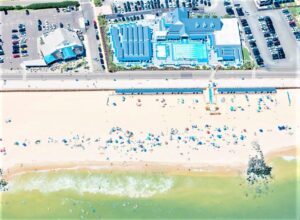
Promenade Beach Club, 2019. In 1999, club developers-owners James McDuffie, John Chimento and Joseph Lagrotteria acquired the 3.1-acre site from the city for $494,000.
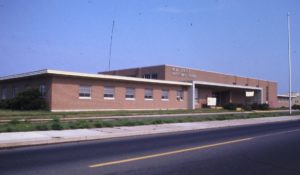
New Jersey National Guard Armory at Ocean and cooper Avenues, 1980s. Dedicated in September 1959 and built at a $322,000 cost, the facility was used by the 250th Quartermaster Battalion. It had a 7,000-square-foot drill area, gun range, kitchen, classrooms and could accommodate 2,000 in its auditorium.

Army Maneuvers — Mayor Daniel Maher (r) at the grand opening of the NJ National Guard Armory at Ocean and cooper Avenues, Long Branch Daily Record, September 1959. At left is Colonel Frank N. Kaiser, the new station commander.
Breakwater Beach Club
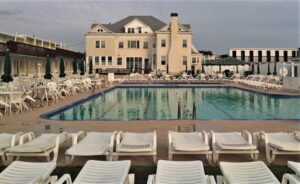
Breakwater Beach Club on Ocean Avenue in Elberon. The private club opened in June 1957 with partners: Abe Vogel, Leopold Hechter, Irving Kaye, Harry Glassberg, and Sol Tepper.
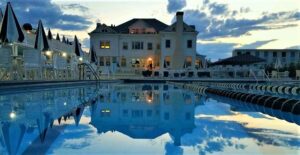
Breakwater Beach Club, 2017. Vogel, who also co-owned Vogel’s Department Store on Broadway and did some part-time acting, later became the sole club owner. He died in May 2007.
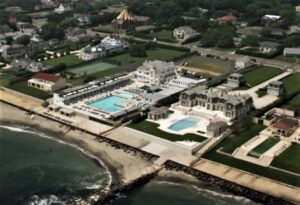
Breakwater Beach Club, 2010s. Designed by H. Irving Braun, the club was called a “palatial arrangement of pools, cabanas and myriad other facilities for summer recreation” upon its opening in 1957.
Elberon Bathing Club
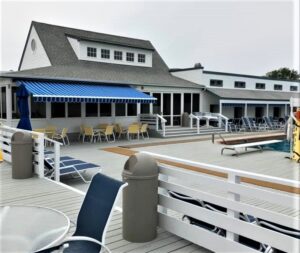
Elberon Bathing Club on Ocean Avenue in Elberon, 2019 — MORE INFO.
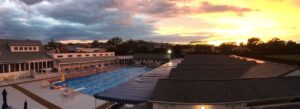
Elberon Bathing Club. In 1934 on oceanfront land he owned, Gene Sperry (a wealthy New York lawyer and mayor of Deal) helped organize the club and build a facility in Long Branch. The wife of Sperry’s chauffeur ran the club snack bar. By 1943 the club was incorporated.
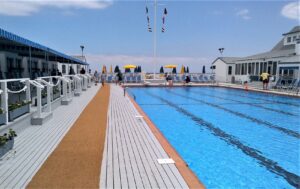
Elberon Bathing Club pool, 2000s. Beginning in Summer 1943, Coach Alfred Neuschaefer was the club’s swimming director. A member of the International Swimming Hall of Fame, “Neusch” is the only high school swim coach to gain hall entry. His Trenton High School swim teams won 19 NJ state titles before he retired in 1960. The Newark native and Rutgers grad died in July 1977.
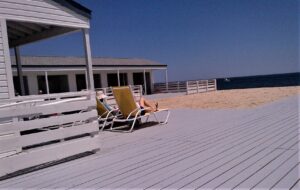
Elberon Bathing Club. Among the famous members were: Toots Shor, flamboyant NYC saloon keeper; Sonny Werblin, New York Jets owner; and Lester Markel, creator of the New York Times Book Review section.
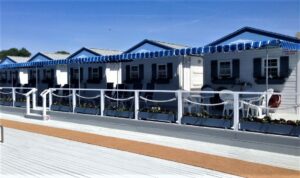
EBC cabanas in a row, 2015. In a 1952 APP news story, Edwin Bry, then president, said that operations at the non-profit club began in 1921.
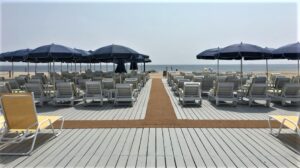
EBC decked out, 2019. During the 1920s and 1930s, it was a private beach club for Bloomingdale family members and friends — the department store magnates.
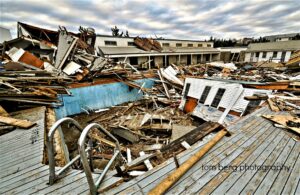
EBC in ruins after Superstorm Sandy, 2013 (Tom Berg Photo).
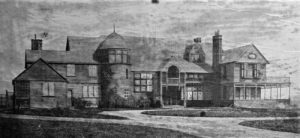
Bloomingdale house on Ocean Avenue in Elberon, 1881. The architects were McKim, Mead & White. Cost to build: $33,000. Back then H. Victor Newcomb, a railroad tycoon and banker, owned the property. Lyman Bloomingdale bought the house in 1901.
Takanassee Beach Club
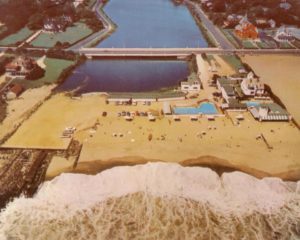
Takanassee Beach Club aerial image, 1960s. During peak seasons, club members enjoyed 600-feet of beachfront, spread over 5 acres of property, set among several historic buildings. Pretty choice stuff.
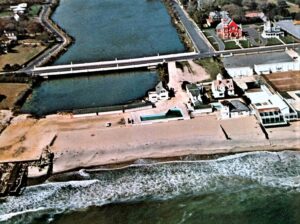
Takanassee Beach Club, 1965. The Peters family first acquired the property in 1924 and by June 1932 the club was operating. Rhoda “Ginny” Peters and her husband James ran things for decades.
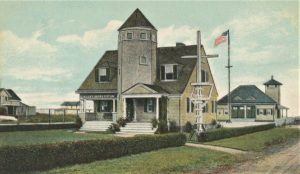
US Life-Saving Service station #5 at Takanassee Beach, 1908. Called surfmen, this incredibly brave group operated here until 1915 under the oath: “You have to go out; you don’t have to come back.” Opened in 1880, the building later housed parts of the beach club.
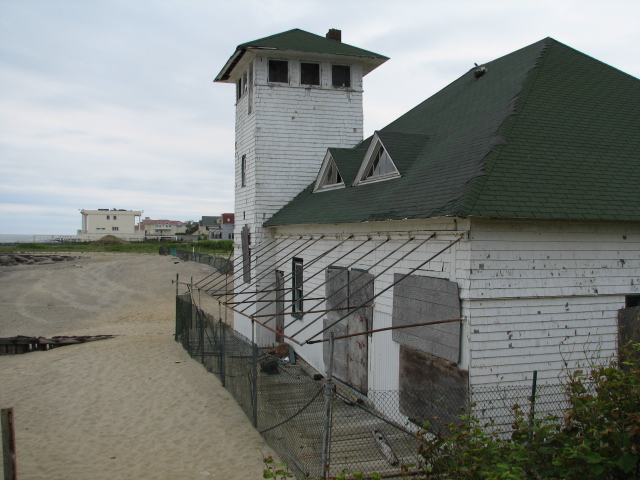
Takanassee Beach Club remains in West End, 2009. In 1955, the Peters expanded their beach club operations paying about $25,000 to the US government for an acre of beachfront and a large building and smaller boathouse.
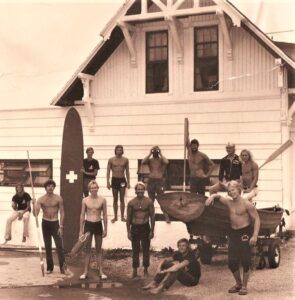
Takanassee Beach Club lifeguards, 1973. Dick Martin (c) — TBC’s captain of the guards from 1961 to 1982 — led one of the Jersey Shore’s finest group of guards.
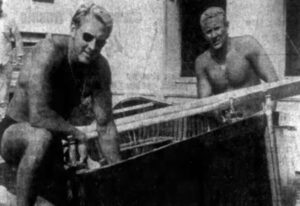
Takanassee Beach Club lifeguards Dick Martin and Pete Dutoit with the canoe they used to win the 700-yard boat race at an Asbury Park lifeguard tourney, Long Branch Daily Record, August 1967. Captain Martin kept “well -drilled teams” who were perennial champs during 1970s shore area lifeguard tournaments.
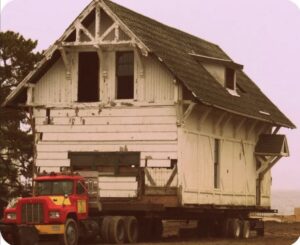
Takanassee Beach Club building is moved to a new location in Elberon, May 2012. The “Port Huron” design section dates back to 1903 and the historic US Life-Saving Service.
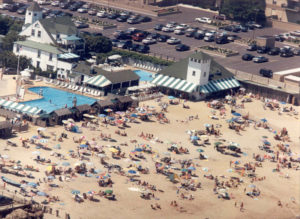
Takanassee Beach Club aerial image, 2000. For nearly 80 years, the Peters family ran the beach club from beginning to end.
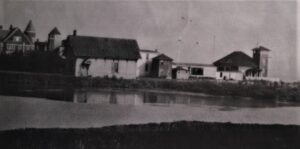
Takanassee Beach Club in the early days. Developer Isaac Chera acquired the club property in 2008, paying $17 million to Ginger, Scott and Kristen Peters.
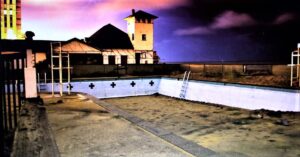
Takanassee Beach Club gone to seed (or sand), 2008. The first pool opened for Summer 1959 and was built by Sylvan Pools for $10,600.
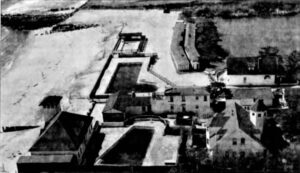
Takanassee Beach Club from above, 2006. The spot also held a US Coast Guard unit that was closed after WW II.
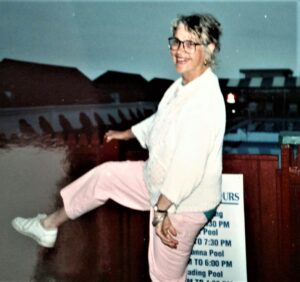
Owner Rhoda Virginia Peters at her Takanassee Beach Club, 1990s. (Beth Anne Duze Woolley Photo). She died in January 1999 and her husband James died in 1970.
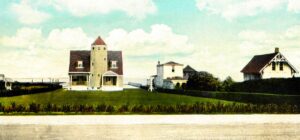
US Life-Saving Station and out buildings, early 1900s. The first LB station was a tiny cabin built in 1855. A new 1875-type station was built in 1878 and a boathouse with a lookout tower were added in 1904.
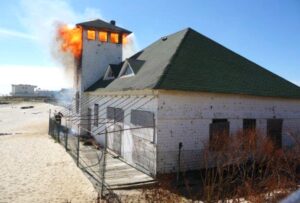
Lost Long Branch Landmark — An abandoned Takanassee Beach Club on fire, August 2013. The structure once housed the venerable US Life-Saving Service and US Coast Guard — before becoming a beach cub in 1933.
Surfside Beach Club
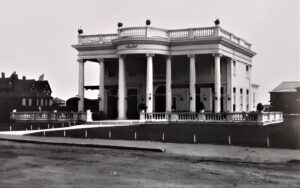
Huyler’s Candy Company store on Ocean Avenue, 1909. The West End spot would become Surfside Beach Club. Huyler’s was a popular NYC area candy, ice cream, and restaurant chain that operated from 1874 to 1964. Chocolate was their specialty.
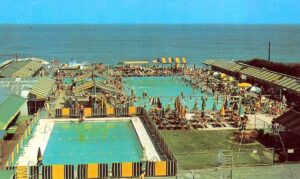
Surfside Pool & Cabana Club, 1960s. John and Anthony “Boots” Cittadino started the club in June 1947 as part of their successful Seashore Day Camp which they launched in 1926.
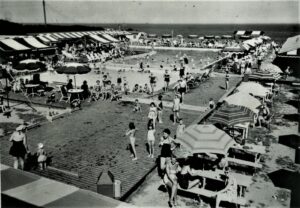
Surfside Beach Club, 1950s. (Long Branch Public Library Photograph Collection).
Elberon Surf Club
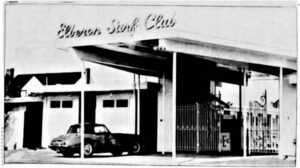
Elberon Surf Club on Ocean Avenue, 1980s. By the Summer 1944, David O. Evans was operating the club which included about 60 members. In the mid-1950s, according to the LB Daily Record, the club obtained the nearby home of Carmine DeSapio for its use. DeSapio was the last Tammany Hall political machine boss to dominate municipal politics in NYC.
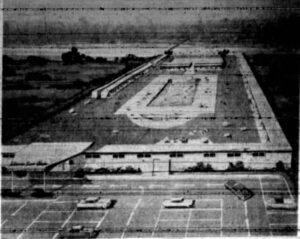
Elberon Surf Club sketch proposal. Long Branch Daily Record, 1957. That was the year the club incorporated as a non-profit. By December 1986, the club and property were sold for about $1.5 million. Beach club operations stopped shortly thereafter.
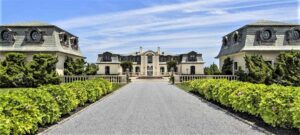
The house were the Elberon Surf Club used to stand. This 14,000-square-foot “Belle Mer” oceanfront estate is on the market for just under $38 million.
White Sands Beach Club
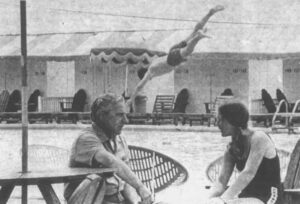
Big Dive — Charles Savoth (l) at his White Sand Beach club in North End, June 1973. The summer before the club had nearly 2,000 members, according to the Long Branch Daily Record. Born in Long Branch, George was a WW II US Navy vet and a former city chamber of commerce president. He died in December 2005.
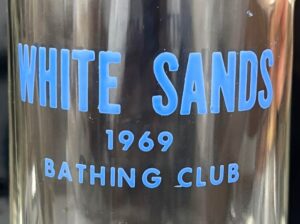
White Sands Beach Club in North Long Branch, 1969. During peak late 1960s summers club property covered 4 acres including 600-feet of prime oceanfront along with a 130 x 60-foot pool.
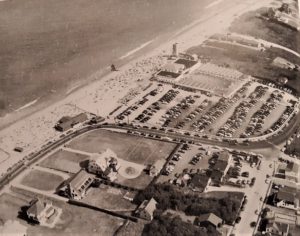
North Long Branch oceanfront, Summer 1952. The Savoth family — including father and son, Charles and George — ran beach club operations in the area dating back to 1929.
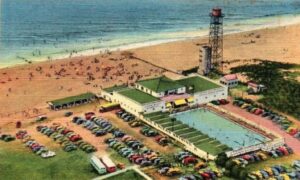
Casino Beach and Pool of North Long Branch, 1940s. Club expansion with 244 bathhouses was done in 1947. It was renamed White Sands Beach Club in 1961.
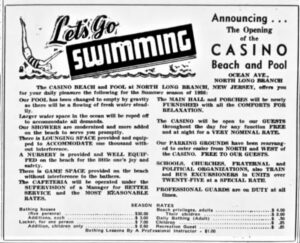
Casino Beach and Pool of North Long Branch opening ad. Long Branch Daily Record, March 1936. The developers were Charles P. Savoth and William Argerakis.
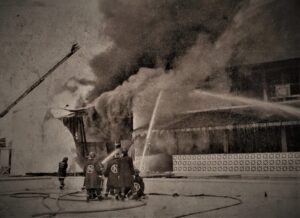
City firefighters battle a blaze at the old White Sands, May 1978. The city had acquired the 4-acre property including 600-feet of oceanfront in December 1973 for $740,000.
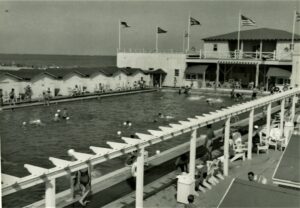
White Sands pool, 1960s. The beach club that’s gone through several names over 30 years. Beginning in 1931, it was the Villa Beach Club, the Sunshine Beach & Pool Club, the Mir-a-Mar Beach Club, the Casino Beach and Pool Club, the North End Beach Club before finally it was the White Sands Beach Club in 1961.
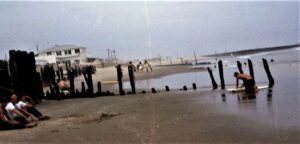
Kiernan’s surfing beach with White Sands in background, 1970. George Savoth was an advocate for North End surfers — providing them with a private beach and adding: “they keep the beach clean and there is no rowdyism among surfers” in 1966, when the Long Branch spot “ranked with the best of them from Ocean City to Sandy Hook.” A city native, Savoth died in December 2005.
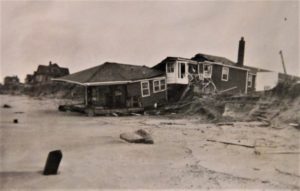
White Sands after storm wreckage, March 1962. Monmouth County later took control of the property and Seven Presidents Oceanfront Park opened in May 1977.
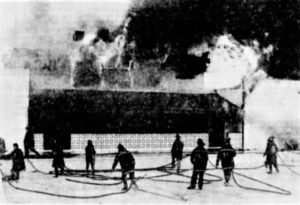
Old White Sands goes up in flames for good and all. It was the “North End Beach Club” when destroyed by two separate fires over two days in May 1978.
Sunshine Pool & Beach
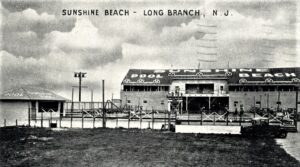
Sunshine Beach Club, 1936. When the Ocean Avenue beach club opened in 1934 it had a 1,000 feet of beach and room for 1,000+ cars. Maurice O’Connell was its president.
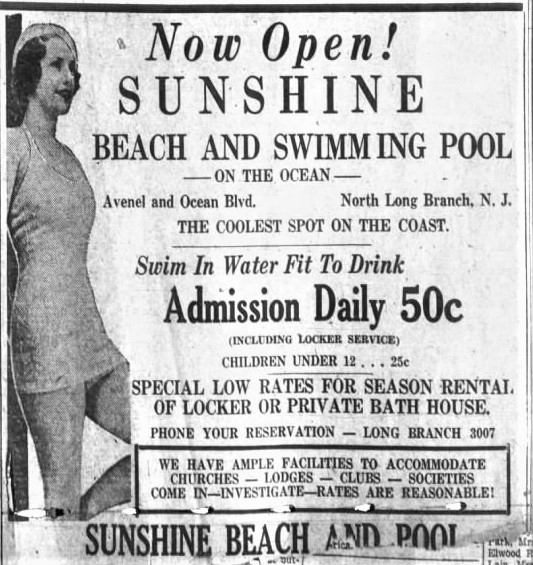
Ad for Sunshine Beach & Pool Club. Long Branch Daily Record, July 1933. It later became the White Sands Beach Club.
Villa Beach Club
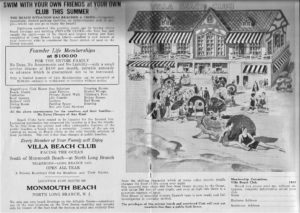
Promotion flyer for a “private beach club” in North End. Built at a cost of $350,000, the Villa Beach Club at North Long Branch opened in July 1931. A.T. Cummins was the builder/manager and Newton White was the first club president. Family membership for the summer was $100. The “spacious club” lasted only one summer and was sold at sheriff’s auction for $37,000 in November 1931. The land had been known as the “McConville estate.” The spot later became the White Sands Beach Club.
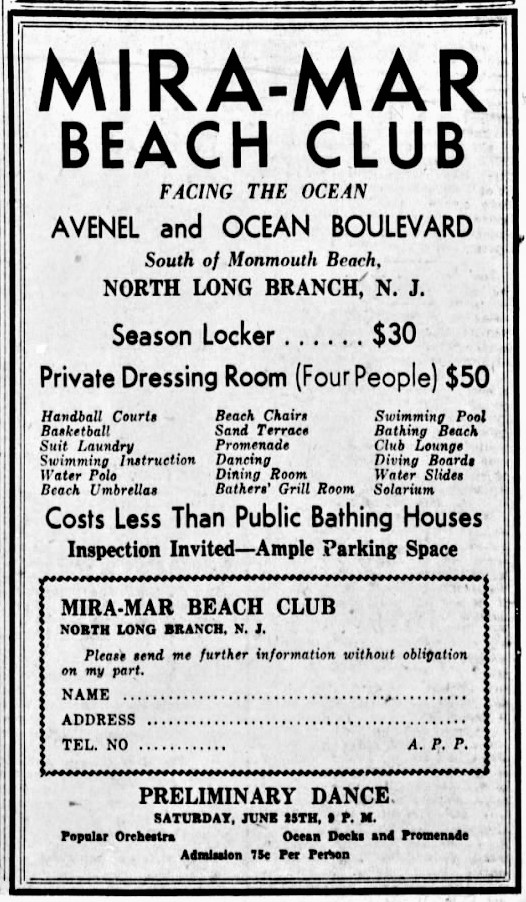
Mir-a-Mar Beach Club in North Long Branch. APP ad, June 1932. It had been the Villa Beach Club. When the newly-named club opened that summer it had a new pool.
USO Beach Club

USO beach club pavilion in North End, 1940s. Opened in June 1943, wrecked in a 1952 storm, a new one was rebuilt in 1954. The Long Branch United Service Organization dates to 1941; its headquarters was on Broadway.
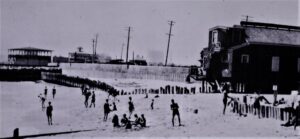
USO beach club in North End, 1940s. For the exclusive use of US military service personal, family and friends.
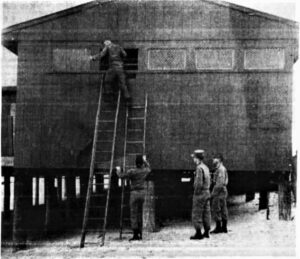
Local soldiers get the USO Beach Club in North End really for another summer. LB Daily Record, April 1961. The facility was destroyed in a major December 1966 fire.
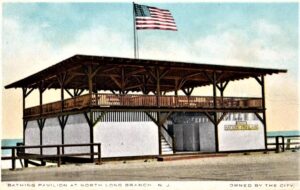
Avenel Bathing Pavilion in North Long Branch postcard. The club dates to 1913. By the late 1920s, the city owned the club and was leasing it out for summer seasons. The spot officially became the USO Beach Club in 1943. Mary Gill was the first supervisor.
Beachcomber Club
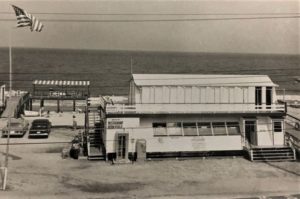
The Beachcomber Club at the end of Atlantic Avenue In North End, 1950s. Stan and James Tsigonis acquired the property in June 1953 — it had been known as “Shipkins” beach club since the 1930s.
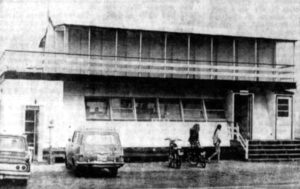
Leteendezvous Surf & Swim Club, 1967. Formerly the Beachcomber Club, the North End facility was changed into a swimming and surfing club — for teenagers only. J. Kelsey Burr was in charge.
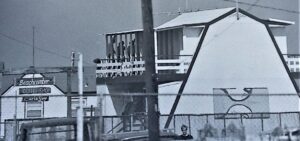
The Beachcomber along the LB oceanfront, 1966. Anthony “Ducky” Schiavo ran the business for several years until 1970 when he opened the nearby Peddler Bicycle Shop. A former school teacher, he died in 2001 at age 57.
West End Casino
